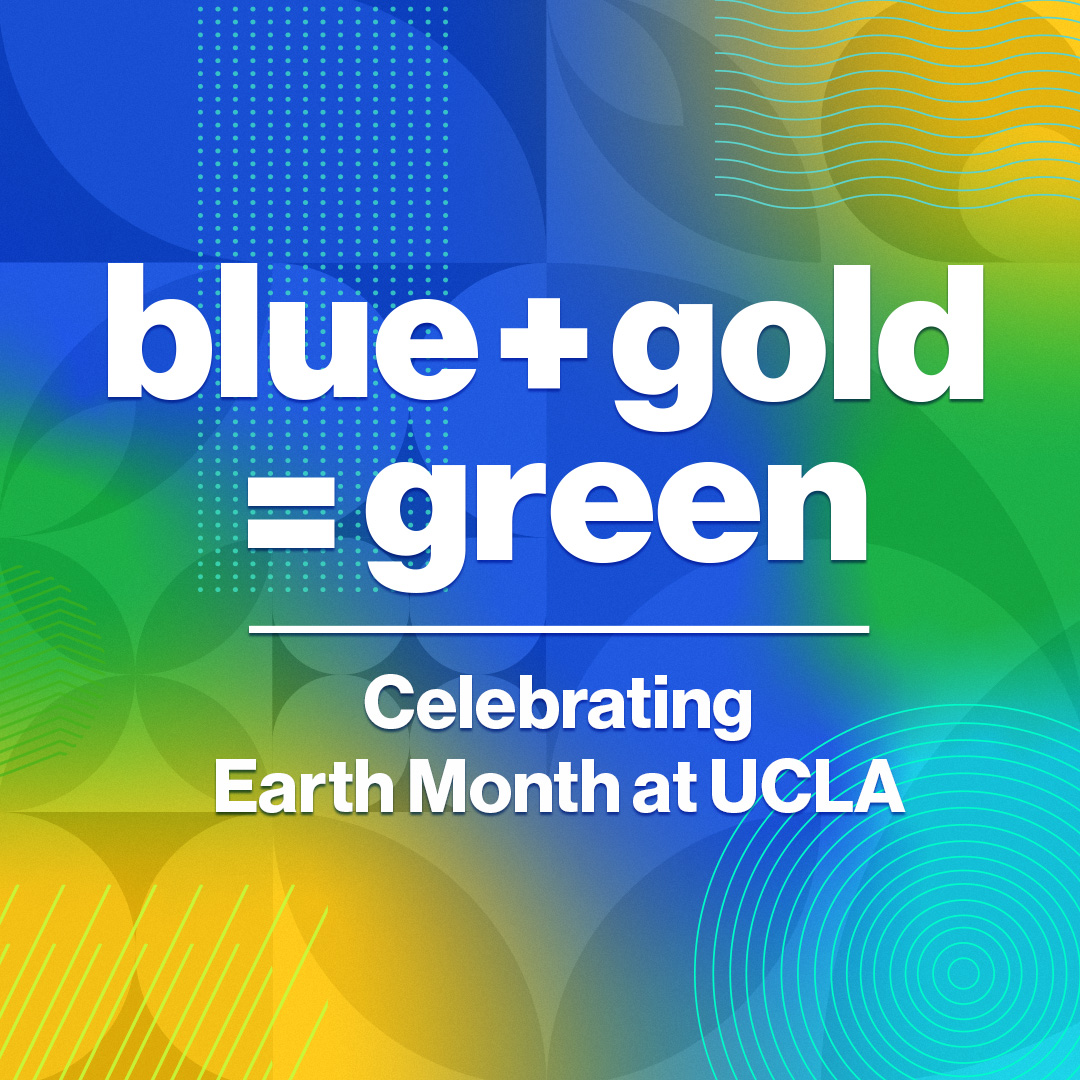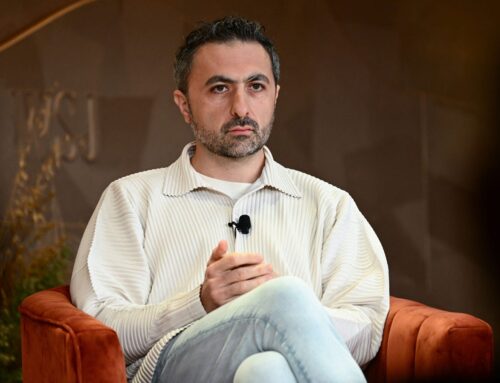The global good: How UCLA is working toward a healthier, cleaner and more sustainable plan
April 1, 2025
For more than 50 years, UCLA has a been world leader in environmentalism and sustainability. Since the launch of the campus’s pioneering environmental studies program in the early 1970s — the first in the UC system and one of the first in the nation — Bruins have been at the vanguard of research and advocacy aimed at protecting the health of the environment and the planet.

Today, that mission has grown into a massive multidisciplinary effort that stretches across schools, departments and units. From the campus grounds to classrooms and laboratories, from city hall to Washington, and from the Port of Los Angeles to the Port of Singapore and a thousand points beyond, UCLA scholarship is transforming how we relate to the natural environment.
As we celebrate Earth Month this April, Newsroom is shining a light on the countless ways in which UCLA’s blue-and-gold goes green — by advancing sustainability, developing climate change solutions, promoting conservation and biodiversity, driving policy at home and around the globe, and educating a new generation of environmentally conscious leaders committed to creating a healthier, cleaner and more sustainable planet.
Read stories from across campus on how UCLA advances sustainability, develops climate change solutions, promotes conservation and biodiversity, and educates a new generation committed to creating a healthier, cleaner and more sustainable planet.
And we’re providing expert tips and advice on what you can do to help in the long run. After all, addressing today’s pressing environmental challenges isn’t a monthlong effort — it’s an ongoing project that involves all of us.
Newsroom’s Earth Month site will be updated regularly, so please check back frequently. In the meantime, browse the content below for a sampling of UCLA’s impressive work — on campus, locally and across the globe.
The campus: A living lab of sustainability
UCLA’s least recognized sustainable jewel might also be its most visible, something Bruins encounter every day— the campus itself. “I think it’s very easy as students, faculty and staff walk around campus for them to not realize how much is going on with sustainability,” said Nurit Katz, UCLA’s chief sustainability officer. “Taking a moment to look around, to learn about sustainability at UCLA, can help give a different perspective on the campus.”

Nurit Katz/UCLA
An area on campus featuring native plants like yarrow and buckwheat.
An early adopter of sustainable practices and environmental stewardship, UCLA has, in recent years, been recognized with a slew of national awards, including a gold star sustainability rating, a Green Grounds certification and a Green Fleet Award, and it is a leader in sustainable buildings, with 65 LEED (Leadership in Energy and Design) certifications from the U.S. Green Building Council. Sustainability efforts — energy efficiency, food system improvements, water use, solar power, waste reduction and more — touch nearly every area of campus operations.
Sustainable campus grounds: Natural pockets of paradise
From the Mildred E. Mathias Botanical Gardens to Sage Hill and Hummingbird Canyon, UCLA takes an ecologically conscious approach to its natural outdoor spaces, green areas that nurture biodiversity, including an array of plants, birds and other wildlife. Today, 90% of campus grounds are managed sustainably and without the use of pesticides. And UCLA has increasingly converted its turf areas to California native, drought-tolerant plants — an effort in large part informed by collaboration with members of the Gabrielino/Tongva tribe, the traditional caretakers of the land where the campus sits. Beyond their natural beauty, these spaces serve as a laboratory for students and faculty in biology, ecology, environmental science and geography have been applying what they have learned in the classroom to Sage Hill.

Artist rendering: Diego Alva; original photo: Lance Patacsil
Inductive charging coils will be installed below a portion of Charles E. Young Dr., allowing electric passenger shuttles and heavy-duty buses to charge while in motion.
Getting around cleanly: A commitment to green transportation
As UCLA marches toward the complete electrification of its bus and vehicle fleet by the time of the 2028 Olympics, it will soon have another feather in its cap: The campus will be the first site in the state California with an electric vehicle–charging roadway — an example that could help advance transit electrification and efficiency across the state’s transportation infrastructure. And the Bruin community continues to adopt more environmentally friendly ways of travel. While the campus population has continued to grow, automobile commutes by employees and students have declined significantly. Transit passes for students allow unlimited-use, fare-fee rides on the seven transit agencies serving the campus. For those employees who do drive, nearly 4,000 head to campus via zero-emission vehicles each workday, putting UCLA’s EV usage among the highest of any college in the country.
For a full snapshot of ongoing sustainability projects and improvements, view the UCLA Sustainability Plan’s progress dashboard and stay engaged by visiting the UCLA Sustainability website and blog.
Connecting UCLA’s sustainability expertise to L.A., California and the nation
When it comes to fostering a more sustainable future locally and nationally, UCLA has always cast a long shadow. Through research, community engagement, and advising on science and policy.
UCLA climate scientists, for example, are bringing their expertise to bear on efforts to improve sustainability across the California. Students are advocating for equitable and ecologically sound policies at the state Capitol. Biologists are working to protect Los Angeles’ biodiversity and ensure a viable future for the city’s mountain lions and other wildlife, while a multidisciplinary, campuswide initiative seeks to help make L.A. the world’s most sustainable megacity. And physicists and engineers are working nationally on the development of carbon-free electricity generation through nuclear fusion.

David Esquivel/UCLA
From left: UCLA Chancellor Julio Frenk watches as County Supervisor Lindsey Horvath speaks at a news conference announcing a blue-ribbon commission to inform wildfire recovery recommendations.
Of prime importance in many of the university’s sustainability efforts is connecting UCLA’s knowledge, and its commitment to environmental and social justice, to the communities that need it the most.
Los Angeles fires: A sustainable, resilient recovery
The recent fires in the Pacific Palisades and Altadena have brought climate change, public policy and environmental health issues to the fore, and Bruins have marshaled their resources to make sure the recovery and rebuilding process for these communities is safe, resilient and sustainable and takes into account the growing threat of global warming. Faculty members in nearly every field, from environmental studies and urban planning to medicine, psychology and biology, have been providing expert analysis, guidance and hands-on assistance, and UCLA and Los Angeles County Supervisor Lindsey Horvath recently announced a blue-ribbon commission that will leverage that UCLA expertise across campus to create policy recommendations for a safe and resilient rebuilding effort. From the engineering school to the school of management, additional efforts have been launched to help address the toxicity, soil erosion, water quality and other pressing ecological and environmental concerns.

iStock.com/samafoto
Creating a more sustainable megacity
UCLA, as a university not only in Los Angeles but of Los Angeles, has long been a dedicated advocate of environmentally conscious policies and practices across the region, where it engages with and empowers local communities to take meaningful action toward sustainability. The university’s many sustainability collaborations with government agencies and community organizations have recently included advising the city on how to transition to 100% renewable energy in a way that centers equity and justice for all its populations, spearheading a project with the city to help residents cope with climate change–related extreme heat and evaluating Los Angeles’ plan to invest billions in wastewater recycling. UCLA is contributing in other ways as well. Last November, the campus signed a memorandum of understanding with the Port of Los Angeles aimed at fostering sustainability-focused learning and research in collaboration with port-adjacent communities. Much of that work will be centered at the new UCLA South Bay campus, which will be gearing up to offer a curriculum based on sustainability, climate change and environmental justice.
Leading the charge for a greener globe
From the Westwood campus and the neighborhoods of Los Angeles, UCLA’s real-world impact extends to every corner of the world. From the Congo Basin to Bali, Bruin scholars are tracking the effects of global warming, protecting endangered species, preserving forests and other crucial ecosystems, and devising ingenious approaches to the planet’s most pressing environmental challenges.

Charles Grace
A rendering of Gaurav Sant’s ocean-based carbon dioxide–removal pilot plant in Singapore.
Sustainable solutions to climate change
Consider engineering professor Gaurav Sant, who was named one of 2024’s biggest drivers of climate action worldwide by Time magazine. He and his colleagues have built North America’s first commercial-scale, ocean-based carbon dioxide–removal facility — a technology that leverages natural systems to help tackle climate change — and have an additional pilot system in Singapore. An engineering team has also developed a process that could significantly reduce greenhouse gas emissions in cement production — which accounts for more than 8% of global CO2 emissions — and other faculty are working on a new mechanism for cooling buildings while saving energy — just a few of UCLA countless worldwide projects aimed at creating a sustainable future. Student research, as well, continues to make an impact globally: An undergraduate-initiated project in Indonesia used plants as filters to transform contaminated water into clean agricultural water for use in rural communities.

Shutterstock
White-bellied pangolin: A powerful genomic approach by UCLA researchers could boost efforts to slow the illegal hunting and trade of these animals.
Biodiversity, the environment and a warming world
Sustainability and ecological work sometimes require that scholars be not only scientific researchers but detectives. Poaching and the global trade in illegal wildlife, for instance, nets some $20 billion a year, and UCLA faculty have used their knowledge of the genome of the white-bellied pangolin — one of the most highly prized illegally hunted animals — to trace internationally traded pangolin scales back specific sites where the animals were poached. But protecting wildlife and biodiversity isn’t always so dramatic, and much of it involves close observation of slower changes over time, whether that’s monitoring the shrinking of sea ice in the Antarctic, one the most sensitive spots on Earth to climate change, or the mapping the rainforests of Africa, a project that might very well revolutionize climate science.
In all of these efforts, UCLA connects and collaborates with broader community — locally and globally. Through the Bruin family and local stakeholders in Westwood, through UCLA’s global alliances and even through its homegrown Pritzker Emerging Environmental Genius Award — which nurtures those around the world who are bringing bold ideas and energy to the fight to protect the planet — UCLA is ensuring that the research it does not only has an impact but resonates widely with the global community.
After all, the Earth is worth it.
Search
RECENT PRESS RELEASES
Related Post




